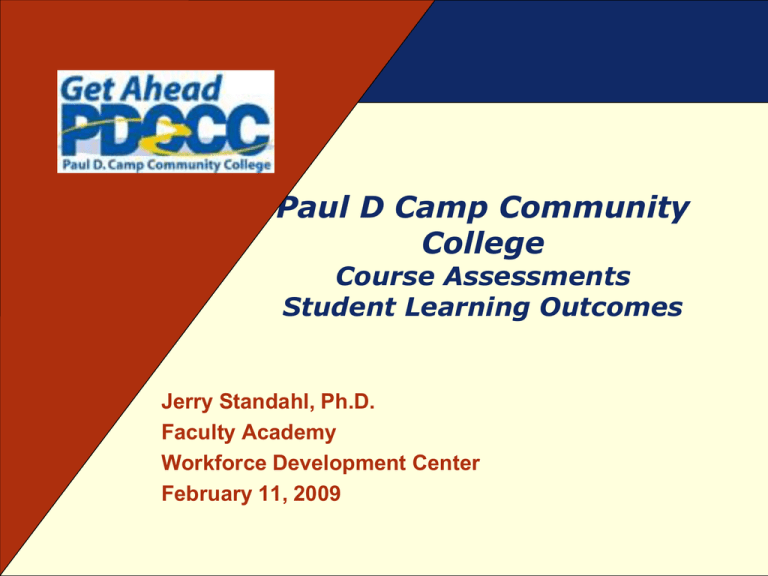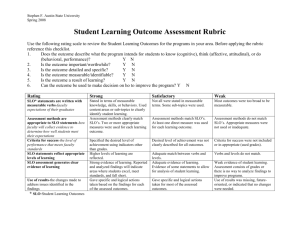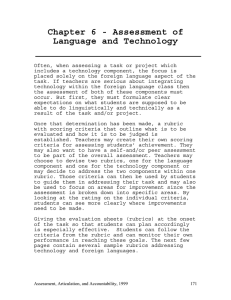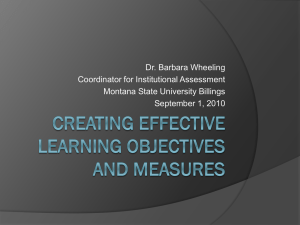Paul D Camp Community College Course Assessments Student Learning Outcomes
advertisement

Paul D Camp Community College Course Assessments Student Learning Outcomes Jerry Standahl, Ph.D. Faculty Academy Workforce Development Center February 11, 2009 Agenda Phases of assessment Assessment definitions Assessment vs. grades Purpose of student learning outcomes Rubrics Assessment timeline Steps to course assessment Bloom’s taxonomy Writing measureable outcomes Phases of an Assessment Program Denial It’s a fad. If I ignore it, it will go away. Acceptance OK, I guess we have to do it. Resistance I feel threatened. My course or my program feels threatened. My campus feels threatened. Can I subvert it by not participating in the process or in some other way? Understanding Maybe we can learn something useful. Can we use what we’ve already been doing? Campaign We have a plan. Maybe it’s not perfect, but let’s get moving! Collaboration We have a plan with long-range objectives that are clearly defined, and, based on our experience with assessment, we believe it works. Institutionalization We can’t imagine working without assessment. It’s a permanent part of our institutional culture. Definitions Assessment The process of gathering evidence to make inferences about how students are progressing toward specific goals (Pennington, 2001) Definitions Goal Goals are broad, generalized statements about what is to be learned or accomplished. Example: Students will understand the General Education requirements at PDCCC Definitions Objectives Objectives are specific, measurable, attainable, realistic, and timely (S.M.A.R.T) Example: Upon completion of PHI 115, students will be able to list all of the General Education areas Objectives are the foundation upon which you can build; that you can prove meet the overall goal Think of objectives as tools you use to reach your goals (how am I going to get there). The purpose is to ensure the outcomes are focused clearly enough so that all involved know what is going on, and so outcomes can be objectively measured Definitions Objectives must be Learner Centered (A statement of what will the student be able to do as a result of a learning activity) Focus on student performance rather than teacher performance Are brief, clear statements that describe desired outcomes Outcomes are used as Benchmarks for assuring course effectiveness Common Mistakes when Creating Objectives Vague Behavior Example: Having a thorough understanding of history. Gibberish Example: Have a deep awareness and thorough humanizing grasp on … Not Student-Focused Example: Train students on how and where to find information. Definitions Target Performance Level Specific, measurable statements identifying the performance(s) required to meet the outcome; Confirmable through evidence (i.e., Students/graduates will be able to list 75% of…). Since you want 100% of students to be able to do something, SACS considers it is better to say, ―Students will be able to list 75% of …‖ than to say ―75% of students will be able to list …‖ Definitions Student Learning Outcomes (SLO) A specific, measurable competency (Knowledge, Skills, Values, or Attitudes) that your students should be able to demonstrate as a result of participation in a learning activity. SLOs can be expressed and measured at the class, program or institutional level. SLOs are not grades, retention rates, graduation rates, enrollments, FTES, or completion rates. SLOs reflect a shift from a focus from ―What am I teaching?‖ to ―What are my students learning?‖ Definitions Direct measures Requires students to display their knowledge and skills as they respond to the instrument itself (i.e. certifications, standardized exams, pre-post test, performance appraisals, portfolios, use of rubrics, oral exams) Indirect Measures Subjective or perceived measures by students which display their knowledge and skills (i.e. questionnaires, surveys, focus groups, archival records) Definitions Rubric A rubric is a set of categories which define and describe the important components of the work being completed, critiqued, or assessed. Each category contains a gradation of levels of completion or competence with a score assigned to each level and a clear description of what performance needs to be met to attain the score at each level. Why use a Rubric? Saves faculty time in assessment which provides timely feedback Provides meaningful detailed feedback that the student/instructor/college can act on Because the rubric is discussed with students at the beginning, they have a better understanding of the instructor’s expectations Encourages critical thinking Facilitates communication with others Helps new faculty to not only be consistent in teaching assignments identified by the course syllabus, but also the expectations for student performance Allows faculty teaching the same course to share rubrics which promotes grade consistency Helps student support services assist students with specific learning problems identified by the rubric Helps us refine our teaching methods Rubrics encourage self-assessment and self-improvement by encouraging students to think, reason, and make judgments based on data Rubrics speed up grading time enormously, thus allowing assignment of more complex tasks instead of focusing on rote memory skills using multiple choice and short answers questions Rubrics will allow faculty to close the loop by identifying problem areas so that improvement to their course/program can be made. Levels the playing field for diverse populations Rubrics act as a translation device in our new diverse environment by spelling out in detail what is expected Work Effectively in Teams <Student Name> Sample Rubric 1Unsatisfactory 2Developing 3Satisfactory 4Exemplary Research & Gather Information Does not collect any information that relates to the topic. Collects very little information – some relates to the topic. Collects some basic information – most relates to the topic. Collects a great deal of information – all relates to the topic. Fulfill Team Role’s Duties Does not perform any duties of assigned team role. Performs very little duties. Performs nearly all duties. Performs all duties of assigned team role. Share Equally Always relies on others to do the work. Rarely does the assigned work – often needs reminding. Usually does the assigned workrarely needs reminding. Always does the assigned work without having to be reminded. Listen to Other Teammates Is always talking– never allows anyone else to speak. Usually doing most of the talking – rarely allows others to speak. Listens, but sometimes talks too much. Listens and speaks a fair amount. Average Score Grades vs. Assessment Grades give a global evaluation but do not provide sufficiently detailed information about which course outcomes students are mastering well and which are giving them trouble Course grades alone don’t stimulate faculty discussions about how to improve student learning of particular course outcomes Grades sometimes are based on more than mastery of course content; Example: Participation, attendance, bonus points Grades standards often vary widely among different instructors and do not indicate the same degree of mastery of course outcomes Grade inflation (easy tests, generous grading, extra-credit bonuses) sometimes presents a misleading indicator of student mastery of course outcomes Assessment vs. Grades Assessment Grades Formative Summative Diagnostic Final Non-Judgmental Evaluative Private Administrative Often Anonymous Identified Partial Integrative Specific Holistic Mainly Subtext Mostly Text Suggestive Rigorous Usually Goal-Directed Usually Content-Driven Purpose for Student Learning Outcomes (SLO) To Communicate to Ourselves With greater clarity the intent of your course If participants gained appropriate skills, attitudes, and knowledge How successful a learning activity has been by measuring it against a benchmark Purpose for Student Learning Outcomes (SLO) To Communicate to Participants What we intend for them to learn in the course If students know what is expected of them, they tend to perform better and rise to that level For self-selection purposes Purpose for Student Learning Outcomes (SLO) To Communicate to Other Interested Stakeholders Required information for Administration, Accrediting Bodies (SACS, SCHEV, IPEDS, VCCS, etc.) The purpose and degree of success of our activities Timeline for Assessing Student Learning Outcomes (SLO) Beginning of term Assessment begin with your course syllabus objectives being written using a student learning outcomes format Your assessment template uses your course (SLO) objectives along with your target performance level for success You decide how to measure each objective (direct and/or indirect; Rubric, test items, skill performance) Send objectives and evaluation methods to your academic Dean Before the end of term Record for each objective what your findings/results are. How will you close the loop (action) to improve on student learning outcomes in your course next semester? An action plan is NOT to send students to tutoring or counseling. It is how you are going to change your teaching methods and activities next time. Send results and action plan to your academic dean with copy to Director Assessment & IR. Example Revision of Course Syllabus Old Course Objectives • To know PDCCC and VCCS policies and procedures •To inform students of support services available to them •To teach students about the skills necessary for successful college adjustment • To show students the Learning Resources Center web page and be familiar with information literacy •To teach effective student skills and memory techniques •To be aware of the college transfer process •To teach interpersonal communication skills •To be acquainted with essential facts concerning AIDS, alcohol and substance abuse •To show students how to access the PDCCC’s Web page New Course SLO Objectives Students will … • Apply knowledge of PDCCC’s policies, procedures, and resources • List necessary survival skills for college success (critical thinking, financial planning, study skills, and time management) • Demonstrate ability to use a computer to access the Internet, the college website, and blackboard •Critique communication skills (oral and written) •Assess knowledge of personal development areas, such as, facts and risk-level pertaining to AIDS, alcohol, and substance abuse Tips in Writing Measurable Outcomes Normally limit outcomes to a maximum of 5 Keep things short and simple (KISS) Make them specific, measurable, attainable, realistic, and timely (S.M.A.R.T) For writing objectives use the Audience-Behavior-ConditionDegree Model (A-B-C-D Model) Establish a target performance level for success (i.e. 70% will …) Keep the assessment process manageable and meaningful (M&M) Assess the same outcome at lease twice to ensure documenting continuous improvement For every outcome define one or more simple measures (direct and indirect; essay, list, multiple-choice, rubric) Use Bloom’s Taxonomy and action verbs Write in the positive instead of the negative Make sure each outcome is high enough Objectives Drive Assessment Approach The action verb in the objective should indicate the appropriate means of measuring that objective Example: ―recognize‖: may indicate matching, multiple choice, etc.—lower-level thinking Example: ―demonstrate‖: may indicate a performance assessment or higher-level demands Entry level courses focus more on lower-level thinking and more advanced courses focus more on higher-level demands Bloom’s Taxonomy & Associated Action Verbs to Create Student Learning Outcomes Objectives Level I: Knowledge Involves recalling information without necessarily understanding it (Describe, Identify, List, Label, Tabulate) Level II: Comprehension Involves understanding learned material (Contract, Describe, Summarize, Classify) Level III: Application Puts ideas & concepts to work in solving problems (Apply, Interpret, Chart, Illustrate) Level IV: Analysis Breaking information into parts to see interrelationships & ideas (Analyze, Contrast, Prioritize, Compare) Level V: Synthesis Puts parts together to form something original (Reorganize, Integrate, Design, Collaborate, Develop) Level VI: Evaluate Judging value of evidence based on criteria (Appraise, Justify, Predict, Rank, Verify, Assess) Bad Words XXX Avoid verbs that are difficult to measure objectively Bad Words-XXX Appreciate Comprehend Grasp significance of Realize Be aware Cover Have faith in Recognize Be comfortable with Enjoy Internalize Study Be acquainted with Familiarize Know Understand Believe Gain knowledge of Learn Value Example SLO Using Bloom’s Taxonomy st PDCCC’s 1TheTime studentCurricular will … Students Retention Rates --Describe the basic components of empirical research Knowledge --Give examples of major themes in music and art --Recognize in complex text local and rhetorical patterns Comprehension --Correctly classify a variety of plant specimens --Explain the scientific method of inquiry --Summarize important cultural traditions in music Application --Demonstrate working knowledge of lab safety procedures --Apply oral communication principles in making a speech --Compute the area of a room Analysis --Distinguish between primary and secondary literature --Diagram a sentence Synthesis --Revise faculty copy for a news story --Formulate hypothesis to guide a research study --Create a poem, painting, design for a building Evaluation --Compare art forms of two diverse cultures --Critically assess an oral presentation S.M.A.R.T Goals/Objectives To Generate Outcomes Specific • A specific goal/objective has a much greater chance of being accomplished than a general goal (Who, What, Where, When, Which and Why) • General Goal –This year I am going to get into shape. • Specific Goal/Objective –This year I am going to join a health club and workout 3 days a week. Measurable • Establish concrete criteria for measuring progress toward the attainment of each goal/objective you set • Stay on track, reach target dates and experience achievement • How much? How many? How will I know when it is accomplished? Attainable • When you identify goals/objectives that are most important to you, you begin to figure out ways you can make them come true. • You develop attitudes, abilities, skills, and financial capacity to reach them. • You can attain most any goal you set when you plan your steps WISELY and establish a time frame that allows you to carry out those steps. Realistic • To be realistic, a goal/objective must represent an objective towards which you are both WILLING and ABLE to work. • Your goal is probably realistic if you truly BELIEVE that it can be accomplished. Timely • A goal/objective should be grounded within a timeframe. With no timeframe tied to it there’s no sense of urgency. • When you set a timeframe, then you have set your unconscious mind into motion to begin working on the goal. Writing Effective and Measurable Objectives: st PDCCC’s 1TheTime Curricular A-B-C-D Model Students Retention RatesExample Element Description A = Audience Who is performing the action? Learning objectives are always stated in terms of student outcomes. Following completion of the Algebra II class, the student should be able to plot a quadratic equation using a graphing calculator in two minutes or less. B = Behavior What will the student be able to do? Use Bloom’s Taxonomy and action verb that describe an accomplishment that is measurable. Following completion of the Algebra II class, the student should be able to plot a quadratic equation using a graphing calculator in two minutes or less. C = Condition Give the conditions under which the performance will occur. Be specific. Following completion of the Algebra II class, the student should be able to plot a quadratic equation using a graphing calculator in two minutes or less. D = Degree Describe the minimum criteria for acceptable student performance. Following completion of the Algebra II class, the student should be able to plot a quadratic equation using a graphing calculator in two minutes or less. The A-B-C-D Model Writing objectives isn’t creative writing: Just follow a formula! Given [Conditions] the [Audience] will [Behavior] by [Degree]. [Audience] will [Behavior] to [Standard] when provided [Conditions]. Exercise: Diagnosing Objectives (Audience – Behavior – Condition – Degree) Participants will be able to name two reasons why objectives are important without handouts or notes. Participants will be able to apply the ABCD Model to their course objectives and syllabus prior to next semester with 100% accuracy. Course Outcome Assessment Plan For <Course being Assessed for Term You Are Teaching> Goal/Objective Evaluation method (With Target Performance level for Success (i.e. 70% will …) (To Evaluate Expected Outcomes (Direct and/or Indirect) Course Objective 1 Course Objective 2 Course Objective 3 Course Objective 4 Course Objective 5 Findings/Results Action to be taken (Closing the loop) Internet Resources for Assessment http://www.pdc.edu/assessment-and-research/assessment-toolkit.php General Principles of Assessment: http://www.tcc.edu/welcome/collegeadmin/OIE/SOA/principles.htm Writing Measurable Learning Outcomes: http://www.adprima.com/objectives.htm Evaluation Methods to Measure Outcomes by Programs: http://www.unf.edu/acadaffairs/IE/alc/ Types of Measures: http://www.provost.wisc.edu/assessment/manual/manual2.html Action Strategies to Closing the Loop: http://www.siue.edu/~deder/assess/catmain.html Rubric Creations: http://rubistar.4teachers.org/index.php http://pareonline.net/getvn.asp?v=7&n=3 http://pareonline.net/getvn.asp?v=7&n=25 Towson Assessment Resources: http://pages.towson.edu/assessment/office_of_assessment.htm NC State Assessment Resources: http://www2.acs.ncsu.edu/UPA/assmt/resource.htm College of Du Page Resources: http://www.cod.edu/outcomes Assessment Peer Review Electronic Journal: http://PAREonline.net Virginia Assessment Group (VAG): http://virginiaassessment.org/RPAJournal.php National Council on Measurement in Education (NCME): http://ncme.org American Educational Research Association: http://aera.net



